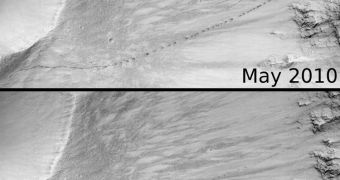Astronomers figured out that Mars is an ever-changing world some time ago, but each time they see something appear or disappear from its surface, they are equally baffled and thrilled. Such was the case when they recently browsed a series of images that covered the same location, but two years apart.
The photos were snapped using the High-Resolution Imaging Science Experiment (HiRISE) instrument aboard the NASA Mars Reconnaissance Orbiter (MRO). The spacecraft has been studying Mars since achieving orbital insertion around the neighboring world, in 2006.
When the HiRISE first imaged the area shown in the image to the left, it saw a long series of tracks left behind by a boulder, as it moved down a steep slope. The markings were so extensive that the camera managed to image them in exquisite detail.
When the MRO passed over the same area in 2012 (one Martian year later), all the markings were gone. Given the absence of significant geological processes on the planet's surface and underground, experts expected to see the tracks there during the second pass.
Apparently, Martian regolith (soil) is renewed at much briefer intervals than originally suspected. This could indicate that the world is considerably more active than geologists were first led to believe.
As far as the disappearance of the boulder tracks go, HiRISE scientist Ross A. Beyer argues that “this is most likely due to the fine bright dust that is transported in the atmosphere falling down and re-covering the dark markings.”
He explains that the boulder roll created these markings by triggering very small dust avalanches every time it touched the regolith. As the dust was stirred into the air, darker-colored soils were exposed underneath. HiRISE is extremely sensitive to such color changes.
According to Beyer, there are two reasons why the boulder fell from the edge of a nearby crater. One explanation could be that a small tremor or a distant meteorite impact shook the ground. A second possibility is that the Martian spring led to the thawing of frozen carbon dioxide (dry ice).
Without this material filling in the gaps between rocks, some become unstable, and eventually break away, Universe Today reports.

 14 DAY TRIAL //
14 DAY TRIAL //